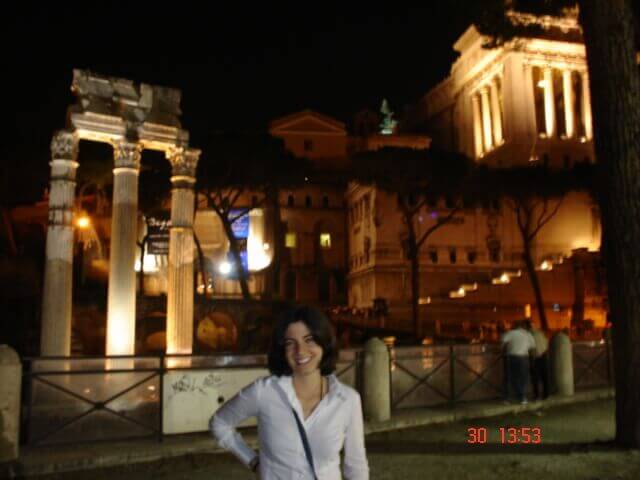The City of Seven Hills is one of the most historic cities in the world. We talk about what was once the center of the Empire that dominated the world. Its three thousand years of history are at the very epicenter of Western civilization.
As travelers, we could not miss this fascinating city. And as travellers traveling within a budget, we could not stop writing this article about what things to visit in Rome for free, or almost.
The Colisseum
The Colosseum is the icon of the city but its past could not be darker: it is estimated that more than 400,000 people died within its walls. This monument dates from the 1st century and has a capacity for 5,000 people, although in its heyday it could hold ten times that number.
To visit this monument, you generally pay about 16 euros per adult (teenagers and adults free), but the first Sunday of each month is free for everyone. Of course, as we always recommend for these “star attractions” we should go early.
The Roman forum
Adjacent to the Colosseum is the Roman Forum. Considered by many to be the most important meeting place in history, it was for centuries the heart of the city of Rome and its center of power. The ruins of the most important public buildings of imperial Rome can still be seen.
It’s so easy to tour these magnificent ruins and imagine the former glory of an empire that ruled from Spain to Persia and from England to Egypt.
The Pantheon in Rome
Built 2,000 years ago, the Pantheon in Rome is a canonical example of classical architecture. Its dome was the largest in the world until the construction of the Firenze Cathedral and an architectural feat.
Since the 7th century it has been a Christian church and despite its great antiquity it is one of the best preserved ancient buildings in Rome.
Pedestrian Rome
Walking through the narrow and twisting streets of Rome is a delight. Visiting the Spanish Steps at the foot of the famous steps and from there strolling the exclusive Via Condotti, with its famous designer shops is a must.
Piazza Navona, which is a 2000-year-old chariot racing circus, is an ideal place if you want to share with other tourists and with the Romans at sunset and at night.
Nearby is the Trevi Fountain, even more famous after the film La Dolce Vita by Fellini.
There is a tradition that says that if you throw a coin into the Trevi Fountain, you will return to Rome. If you throw two, you will meet an Italian love. And if you roll three, you will marry that person. Throws must be made with the back to the source with the right hand and over the left shoulder.
Well, even if you are not a believer in those things, you may be interested to know that an estimated 3,000 euros are thrown daily to this source and in 2016 an estimated 1.4 million euros were thrown to this emblematic source.
The flavors of Rome would not be complete if we did not enjoy a delicious Gelato. They are unique in the world and their flavor is characteristic. Walking around Rome eating a Gelatto is as typical as walking around the city on a scooter.
The Vatican
If you visit Rome, and even more so if you are Catholic, you cannot miss the Vatican. Located within Rome itself, it is an independent city-state and the seat of world Catholicism.
On Sundays at noon the Pope himself officiates a mass and the whole fervent part of Rome (and thousands of visitors from all over the world) congregate in St. Peter’s Square to see the head of the Catholic Church.
St. Peter’s Basilica is a work of art in itself, as well as the Vatican Museums, which house countless works of art from around the world.
A short distance from San Pedro, is the Castello de Sant Angelo. It began as a Mausoleum, then a military fort and then as a papal refuge. There is a legend that says that an underground passage connects Sant Angelo with San Pedro.
Other Visits
Villa Borghese is a beautiful Roman park whose Italian-style gardens serve as a setting for bird species and wonderful flora. Inside this park, there is the Villa Borghese museum. Comparatively little known and visited, but home to authentic Italian Renaissance and Baroque gems in painting and sculpture.
Piazza del Popolo is also a meeting place for tourists and locals, but it has a dark past: for centuries it served as a site of executions, the last of which was in 1826.
The Altar of the Fatherland or Monument to Victor Emmanuel II, is not very loved by the Romans but apparently by tourists. The Romans disparagingly call it the “wedding cake” and claim that it is ugly and has nothing to do with the architecture of the city. In any case, it is very photographed by tourists.
The Roman district of Trastevere is very picturesque with its cafes and trattoria. Have a coffee surrounded by ancient facades in one of the narrow streets will give you a very authentic look at this famous Roman district.
Conclusions
Touring Rome is a visit to the history of Western Civilization. There is practically no achievement of our society or field of knowledge that does not owe something to a greater or lesser extent to the legacy of Rome.
But it is in the little things, like a pedestrian promenade, where we can soak up the essence of Rome, the Eternal City.



